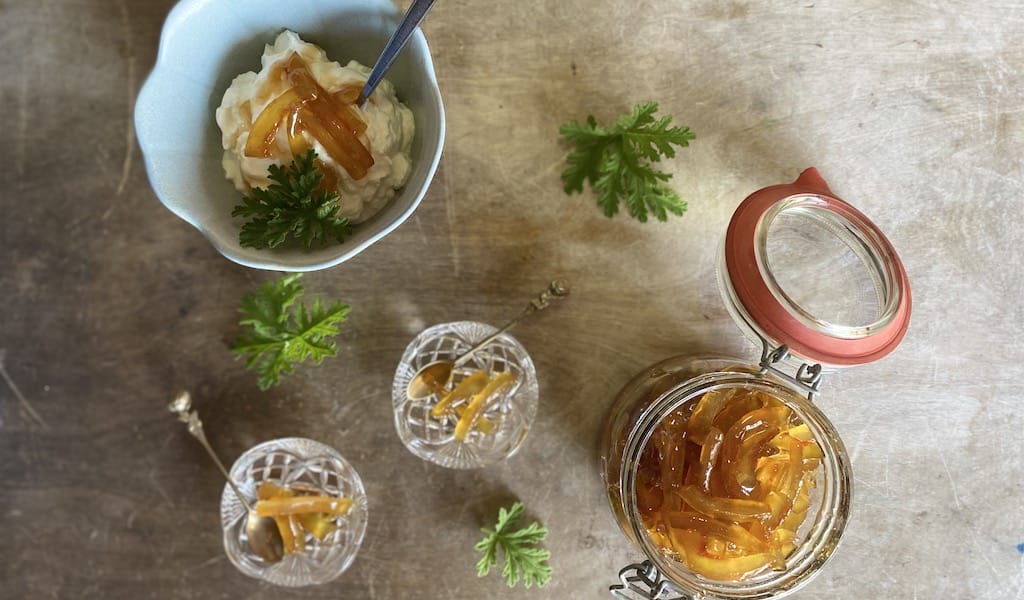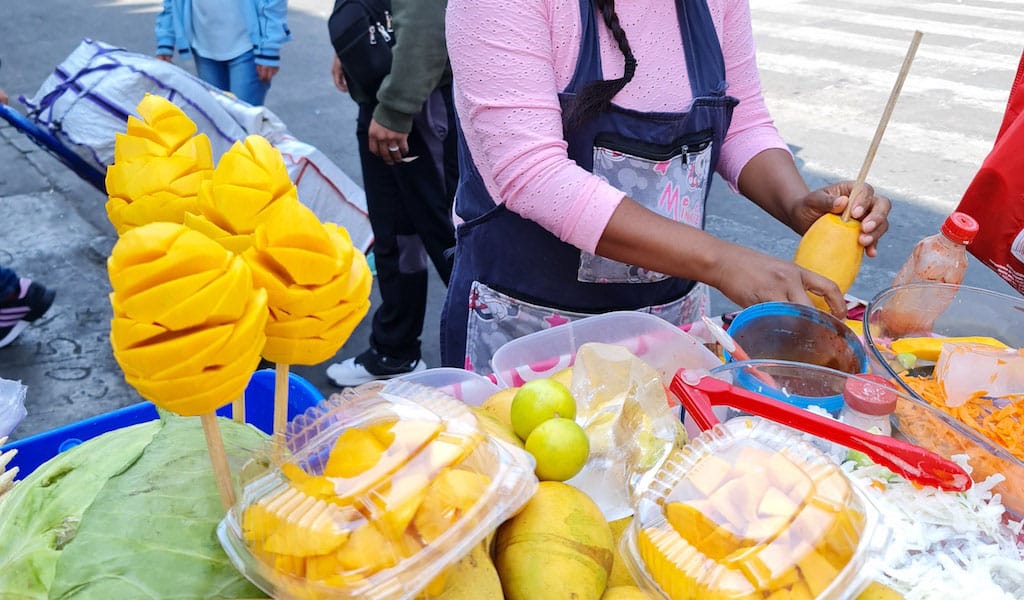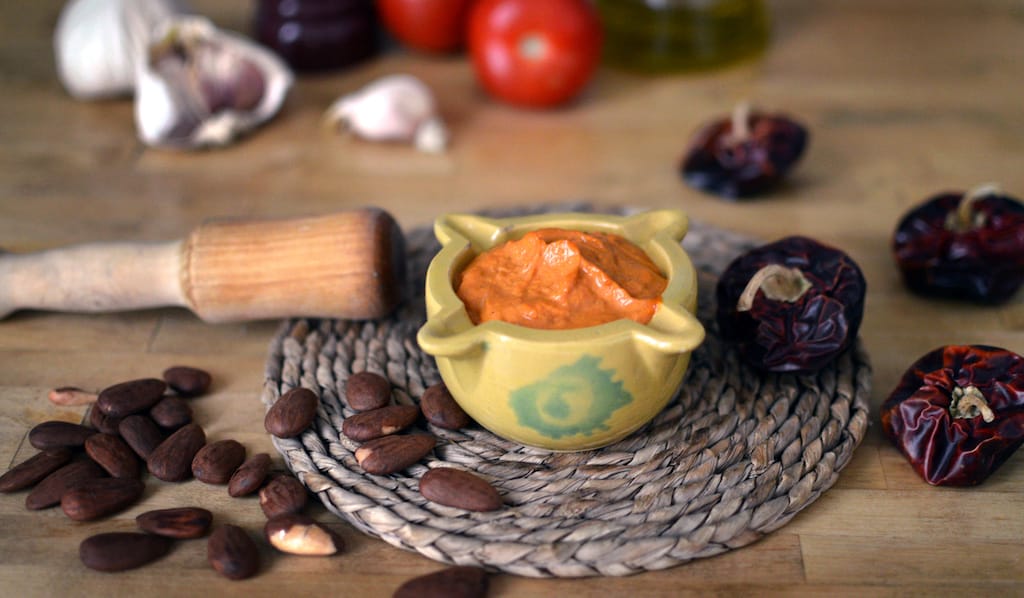As a chef and a mom, I love to get creative with food scraps, the parts that many people would normally throw away – stems, fat, seeds, rinds, skins, bones, etc. To me this is the heart of contemporary gastronomy – cooking with as little waste as possible and managing to create beautiful flavors and textures with humble ingredients. It’s an approach that’s beneficial not just for our own health but also that of the planet.
This urge to limit food waste has led me to study the history of Greek and Mediterranean cuisines, which traditionally revolved around what we now call “sustainable cooking.” One great example of a historic culinary tradition that was all about using everything at hand is the spoon sweet, a type of fruit preserve with ancient roots and the official welcoming treat of Greece – it was traditionally served upon arrival in a Greek home. It provided a way to preserve excess harvest and the non-edible parts of fruits or vegetables as well as to make use of wild fruit that may be too bitter or stiff to eat otherwise. The result is something like a pickle, but sweet!
For example, take watermelon rind. Watermelons are very popular in Greece, where they are the quintessential summer fruit – nothing is better than chilled watermelon on a hot day. Many tavernas will offer complimentary watermelon at the end of a meal, but it tastes just as good when eaten sloppily at the beach, with all the juices running down your chin.
Besides eating it plain, we also use watermelon in salads, or served with feta (a unique umami experience), in granitas, sorbets and juices, and in more traditional recipes like the sticky watermelon pies found on the Cyclades and watermelon liqueur. The rind, meanwhile, makes a brilliant spoon sweet.
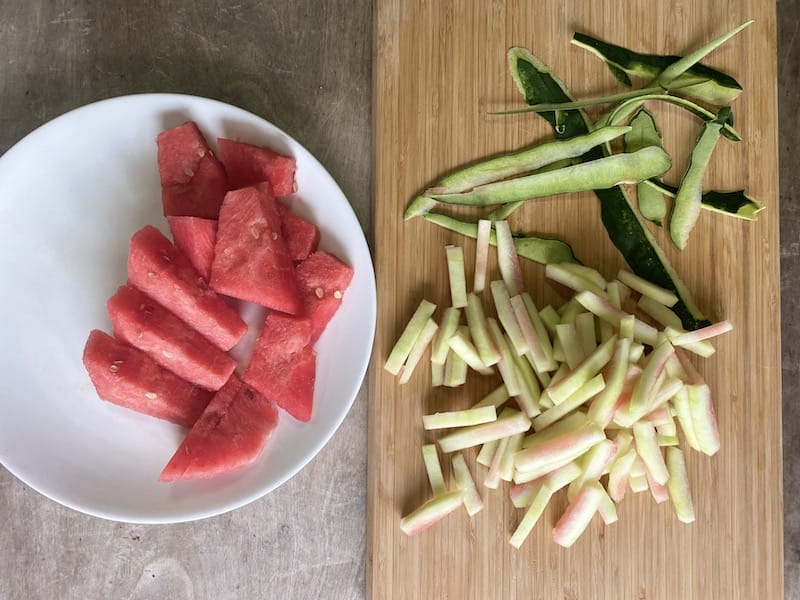
Watermelon spoon sweet is made all over Greece but is traditionally found on the islands of Milos and Ios. It is most often made with the rind, specifically the white section between the green exterior rind and the red fruit – this crispy yet flavorless part is transformed into something useful and tasty.
There are several ways of making this sweet: Many add whole almonds in the sweet while others add rosewater, rose geranium leaves or vanilla to flavor it. I always make it with fresh rose geranium leaves, which provide a wonderful aroma and flavor. I often drink the leaves as a tea, too, especially iced during summer. I keep a couple of rose geranium plants on my balcony as they need little care, keep the mosquitoes away and have a beautiful fragrance, in addition to tasting great in jams and preserves!
One final note: The most important thing is to keep the texture of the rind slightly crispy. I don’t like it when it goes soft and especially if it goes mushy, which means the recipe has failed.
Watermelon Spoon Sweet
1 kg watermelon white rind (red and green part removed)
800 gr sugar
Rind of 1 organic lemon
Juice of 1 lemon + 3 tsp of lemon juice
200 gr honey (preferably thyme or orange blossom)
2-3 small fresh rose geranium leaves (or, if you can’t find these, vanilla)
Ice
1 ¾ cups water
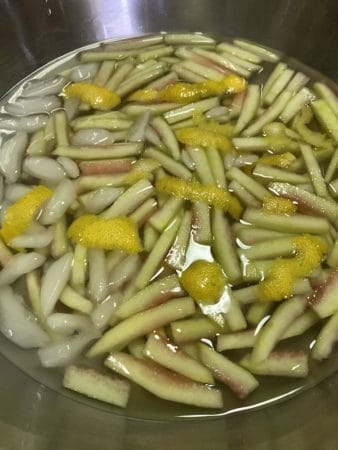 First prepare the watermelon rind. Separate the fruit from the rind and then use a peeler to remove the green external part, keeping the white part with just traces of the red part on it (it adds flavor). Once this is ready, slice it into sticks that are about the length of a matchstick (I like it cut into sticks that are around 4cm long and 1cm thick but many often cut it into bigger chunks). Wash with cold water, put in a bowl and cover with cold water and ice cubes. Add in the juice and rind of one lemon. Cover and put in the fridge for a couple of hours. This will help to keep the texture firm and crispy. Strain the sticks and place on kitchen towel to drain (with the lemon rind).
First prepare the watermelon rind. Separate the fruit from the rind and then use a peeler to remove the green external part, keeping the white part with just traces of the red part on it (it adds flavor). Once this is ready, slice it into sticks that are about the length of a matchstick (I like it cut into sticks that are around 4cm long and 1cm thick but many often cut it into bigger chunks). Wash with cold water, put in a bowl and cover with cold water and ice cubes. Add in the juice and rind of one lemon. Cover and put in the fridge for a couple of hours. This will help to keep the texture firm and crispy. Strain the sticks and place on kitchen towel to drain (with the lemon rind).
Put the water in a saucepan and add the sugar. Bring to boil and add in the watermelon rind (with lemon rind) and simmer for 15 minutes (remove any froth that forms on top with a slotted spoon). Remove from heat, leave it uncovered until it cools, and then cover and let stand overnight in the saucepan (you may leave it standing like this for up to 24 hours).
The next day, you need to thicken up your syrup. Remove the lemon rind and throw away. Remove the watermelon and set aside. Turn on the heat and bring the syrup to boil (low heat). Add in the honey, gently stir and simmer at low heat for about 15 minutes until your syrup is starting to thicken. Add in the rose geranium leaves, lemon juice and watermelon. Bring it to boil once again for another couple of minutes and remove from heat. To test if the syrup’s ready, you need a teaspoon and a plate. Drip some syrup from the teaspoon onto a plate, and if it stands on the plate as a firm drop, it means it’s ready. Don’t over simmer because it will caramelize.
Let cool completely and put into sterilized jars. Although it isn’t necessary, I like to keep it in the fridge to keep it chilled. I love eating it plain, on pancakes, or with ice cream, but above all I like it on my plain yogurt.
To convert metric measurements to U.S. and British kitchen units, click here.
 April 22, 2022 Spring (Food) Break
April 22, 2022 Spring (Food) Break
We know that spring has arrived in Mexico City when street carts crowned with whole […] Posted in Mexico City April 2, 2024 Grandma’s Folar Recipe
April 2, 2024 Grandma’s Folar Recipe
Folar is the generic name given to traditional Easter sweet bread in Portugal. Making it […] Posted in Lisbon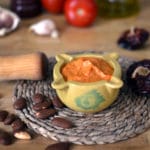 March 20, 2024 Recipe
March 20, 2024 Recipe
Served as a sauce, romesco is certainly striking: It has an intense dark orange color […] Posted in Barcelona
Published on July 17, 2020
Related stories
April 22, 2022
Mexico CityWe know that spring has arrived in Mexico City when street carts crowned with whole mangoes begin to roll into town. While wandering the Centro Histórico’s bustling streets just last week, we bumped into Maria, a seasonal worker whose cart is currently laden with this favorite springtime fruit. Intrigued, we stopped to watch as she…
April 2, 2024
LisbonFolar is the generic name given to traditional Easter sweet bread in Portugal. Making it from scratch is somewhat of a long process, but being confined due to the coronavirus crisis, we seem to have a bit more time on our hands than expected. My family’s folar recipe is from my grandmother Felismina, who was…
March 20, 2024
BarcelonaServed as a sauce, romesco is certainly striking: It has an intense dark orange color and a dense texture that saturates and blankets whatever you dip in it. Once in the mouth, you get a piquant touch of vinegar, which is soon enveloped by the nutty creaminess of ground almonds (or perhaps hazelnuts) and olive…







































